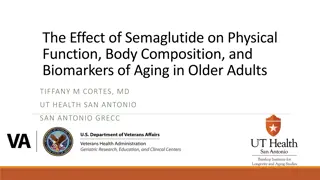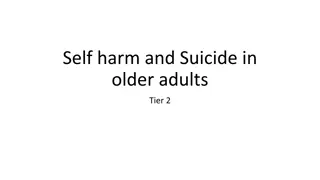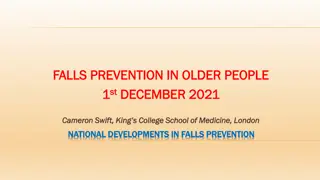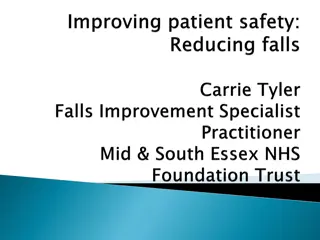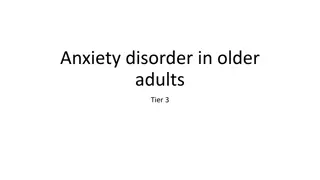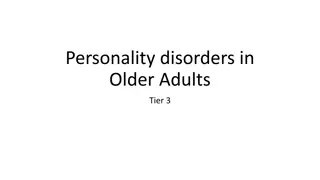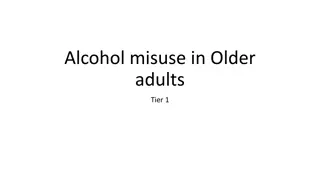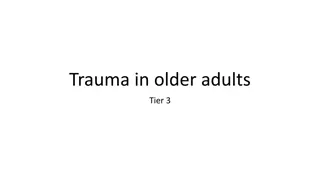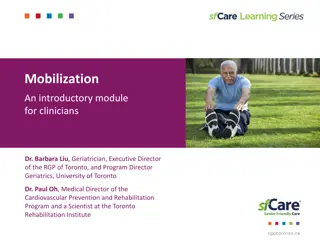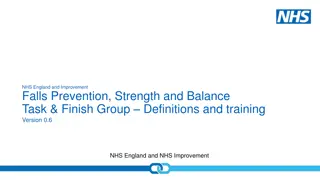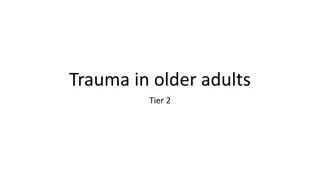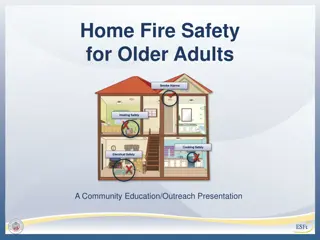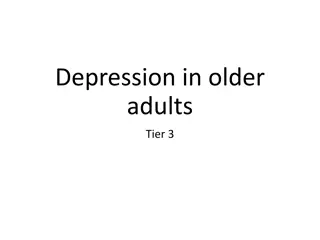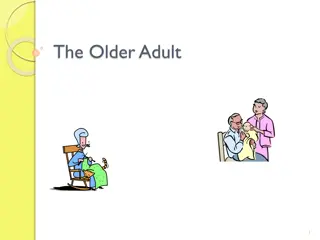Falls in Older Adults: A Comprehensive Overview
Falls among older adults are a significant public health concern, often leading to serious injuries and even death. This presentation highlights the prevalence, causes, impacts, and potential risk factors associated with falls in the elderly population. With insights on why people fall, the consequences of falls, and the burden on healthcare systems, it emphasizes the importance of fall prevention strategies to enhance the well-being of older individuals.
Download Presentation

Please find below an Image/Link to download the presentation.
The content on the website is provided AS IS for your information and personal use only. It may not be sold, licensed, or shared on other websites without obtaining consent from the author. Download presentation by click this link. If you encounter any issues during the download, it is possible that the publisher has removed the file from their server.
E N D
Presentation Transcript
1 October 2019 Presentation for Healthcare Professionals Presentation for Healthcare Professionals Created for theChartered Society of Physiotherapy by Kate Bennett Specialist Physiotherapist
Falls are a common, but often overlooked, cause of injury. Around one in three adults over 65 who live at home will have at least one fall a year, and this rises to approximately half of all people aged over 80 years Falls: applying All Our Health, Public Health England (2018). www.gov.uk/government/publications/falls-applying-all-our-health/falls-applying-all-our-health
Some facts about falls Some facts about falls Falls are the second leading cause of accidental or unintentional injury deaths worldwide Falls, World Health Organization (2018), www.who.int/news-room/fact-sheets/detail/falls Rate of falls among community-dwelling older people over 64 years of age, 28-38% fall each year. Of those who are 70 years and older, approximately 32-42% fall each year. The frequency of falls increases with age and frailty level. A Global Report on Falls Prevention Epidemiology of Falls, Yoshida, S (2011), World Health Organization
Impact of falls in the UK Impact of falls in the UK Falls and fractures in people aged 65 and over account for over 4 million hospital bed days each year in England alone WHO, 2016 The healthcare cost associated with fragility fractures is estimated at 2 billion a year. Falling Standards, broken promises: report of the national audit of falls and bone health in older people, Royal College of Physicians (2011)
Why people fall Why people fall Previous falls Medication Night time mobility Postural hypotension Issues with eyesight Foot wear and foot care Slips and trips Long term conditions Home environment Alcohol Poor strength and balance Vitamin D levels Vestibular issues Being inactive Lack of mobility
After a fall, an older person has a 50 per cent probability of having their mobility seriously impaired and a 10 per cent probability of dying within a year Towards Common Ground The Help the Aged manifesto for lifetime neighbourhoods, Age UK (2008)
What happens after a serious fall? What happens after a serious fall? A fall leads to fear of falling Leads to people being less active Leads to a decrease in strength and balance Leads to another fall Leads to people being less active Leads to greater fear of falling Leads to a decrease in strength and balance etc. etc
CSP Fall Prevention Economic Model CSP Fall Prevention Economic Model In 2014the Chartered Society of Physiotherapy produced a Falls Prevention Economic Model It answers the question, Is physiotherapy a cost-effective way of preventing falls in a given elderly population? Answer is a resounding, Yes physiotherapy can probably prevent around 160,000 serious falls and a spend of 252m across the UK each year. For every 1 spent on physiotherapy, around 4 is returned in prevented NHS spending. The cost of falls, The Chartered Society of Physiotherapy (2018), www.csp.org.uk/costoffalls
Timed Up and Go Timed Up and Go A simple test to determine if your patient is at a higher risk of falls www.csp.org.uk/getupandgo If the test takes 14 seconds or more, your patient could be at risk of falls refer onto your local falls service for a multifactorial assessment.
Gait speed Gait speed Another simple test that may indicate a higher risk of falls www.youtube.com/watch?v=vrm4JP7l1Ms Gait Speed = distance / time: e.g. metres/sec. Values of 0.6 1.0 m/s are suggestive of an increased falls risk. Can gait speed test be used as a falls risk screening tool in community dwelling older adults? A review, Abu Samah, Z et al (2016), Polish Annals of Medicine 23 (1):61-67.
How to get up from a fall How to get up from a fall
Many older adults would not choose to participate in an exercise programme even if it reduced falls to 0% World Confederation for Physical Therapy, WCPT Congress (2017)
Evidence for exercise Evidence for exercise A review in 2018 advised on the amount of activity adults over the age of 65 should do The recommendation was to do at least 150 minutes of moderate aerobic activity such as cycling or walking every week and Strength exercises on 2 or more days a week that work all the major muscles (legs, hips, back, abdomen, chest, shoulders and arms. Exercise to prevent falls in older adults: an updated meta-analysis and best practice recommendations, Sherrington et al (2011), New South Wales Public Health Bulletin 22 (3-4):78-83
Activities to assist with Activities to assist with strength and balance strength and balance DISCLAIMER: The activities described here should not cause any harm. They might not, however, be suitable for all people, particularly those at risk of falls and fractures. Consult a chartered physiotherapist or your GP before embarking on any new fitness regime, and if you do experience pain or discomfort as a result of any of the exercises, stop immediately.
In conclusion In conclusion Falls are a big problem amongst the older population leading to major injury, loss of independence and social isolation Reasons behind falls are often complex but simple interventions such as exercise can reduce the risk significantly Strength and balance exercises have been shown to be effective at reducing falls and the risk of falls By acting now to prevent falls you can ensure your patient s age better, independence is maintained and they are given the best chance to live an active and fulfilling life, free from disability and the other potential consequences of a fall.
Useful links and resources Useful links and resources www.csp.org.uk/nevertoolate www.csp.org.uk/ageukfalls www.csp.org.uk/thinkphysio www.nhs.uk/live-well/exercise/physical-activity-guidelines-older-adults/



